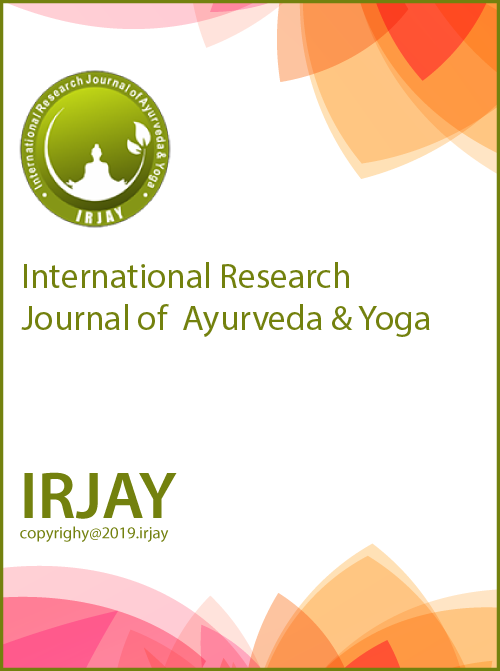A Case Report on Management of Non-alcoholic Grade 2 Fatty Liver WSR Yakrit Vikara through Ayurvedic Intervention
DOI:
https://doi.org/10.48165/IRJAY.2025.80506Keywords:
Arogyavaradhini Vati, , Ayurveda,, Capsule Kalamegha, Makoi Arka, Medohara Guggulu,, Purnanava mandoor,, Yakrit VikaraAbstract
One of the most prevalent liver conditions in the world, fatty liver, is typically brought on by lipid build-up, primarily triglycerides in hepatocytes. Although the liver naturally contains fat, fatty liver can develop if the amount of fat exceeds 5–10% of the liver’s total weight. Yakrit (liver) is considered as a crucial organ responsible for digestion, metabolism, detoxification in body. In Ayurveda non-alcoholic grade 2 fatty liver disease can be related with Yakrit Vikara primarily caused by imbalance of Pitta Dosha leading to conditions such as jaundice, fatty liver, liver cirrhosis and hepatitis etc. this case study examines the clinical presentation, diagnosis and treatment of a male patient aged 60 years with complaint of gaseous abdomen, increased body weight, pain in right side of abdomen, and incomplete bowel evacuation since last 2 months. Diagnostic ultrasound report confirmed grade 2 fatty liver in both lobes.
Downloads
References
1. Mishra B. Bhavaprakasha with vidyotini hindi commentary by Pt. B.S Sharma. 7th ed., Ch. 33., Part 2. Varanasi: Chaukhamba Sanskrit Samsthana; 2000. p. 348-50.
2. Sitaram B. Bhavaprakasha samhita of Acharya bhavamishra, English commentary. Madhyama Khanda. Varanasi: Chowkhambha Orientalia; 2016.
36 Kumar, et al.: Management of Non-alcoholic Grade 2 Fatty Liver through Ayurvedic Intervention 2025; 8(5):33-38
3. Acharya YT, editor. Sushruta samhita of sushruta with the nibandhasangraha commentary of dalhanacharya. Varanasi: Chaukhambha Surbharti Prakashan; 2017.
4. Sastri Pradakara HS, editor. Ashtanga hridaya of vagbhata. Sutrasthana. Ch. 14., Ver. 21. Varanasi: Chaukhambha Sanskrit Sansthan; 2012. p. 226.
5. European Association for the Study of the Liver (EASL), European Association for the Study of Diabetes (EASD), European Association for the Study of Obesity (EASO). EASL-EASD-EASO clinical practice guidelines for the management of non-alcoholic fatty liver disease. J Hepatol. 2016;64:1388-402.
6. Review Team, LaBrecque DR, Abbas Z, Anania F, Ferenci P, Khan AG, Goh KL, Hamid SS, Isakov V, Lizarzabal M, Peñaranda MM, Ramos JF, Sarin S, Stimac D, Thomson AB, Umar M, Krabshuis J, LeMair A; World Gastroenterology Organisation. World gastroenterology organisation global guidelines: Nonalcoholic fatty liver disease and nonalcoholic steatohepatitis. J Clin Gastroenterol. 2014;48:467-73.
7. Acharya YT, Agnivesha. Charaka samhita, agnivesha treatise refined and annoted by charaka, reduced by dridhbala ayurveda Deepika commentary by chakrapanidatta. Varanasi: Chaukhamba Prakashana; 2011. p. 484, 738.
8. Trikamji VY, editor. Sushrutha. Sushruta Samhita with nibandha sangraha vyakhya by dalhanachrya and nyayachandrika khyapanji
kavyakhya by Gayadasa. 8th ed. Varanasi: Chaukhamba Krishnadas Academy; 2013. p. 458.
9. Padmaja D, Maheshwar T, Anuradha D, Koteswara Rao CV. Arogyavardhini vati - a boon for liver disorders from ayurveda (fatty liver). Ayushdhara. 2021;8:3418-25.
10. Santhosha DU, Manasa R, Vishwanath S, Shekhara Naik R, Mahesh MS. Hepatoprotective activity of Boerhaavia diffusa L. IP J Nutr Metab Health Sci. 2020;3:109-13.
11. Sabharwal S, Singh S, Anand N, Kaur S. An overview on Kalamegha (Andrographis paniculata). Asian Pac J Health Sci. 2021;8:57-65. 12. Singh S. A clinical study on hyperlipidemia with medohara guggulu and lekhaniya mahakashaya. Int Ayurvedic Med J. 2016;4: 606-612. 13. Tripathi B. Charak samhita of viman sthana, charak chandrika. Vol. 1, 8/143. Varanasi: Chaukhabha Subharti Prakashan; 2008. p. 782. 14. Shastri A. Sushrut samhita of sutra sthan, Ayurveda tatva sandipika. Part 1, 38/18. Varanasi: Chaukhabha Subharti Prakashan; 2010. p. 184.

